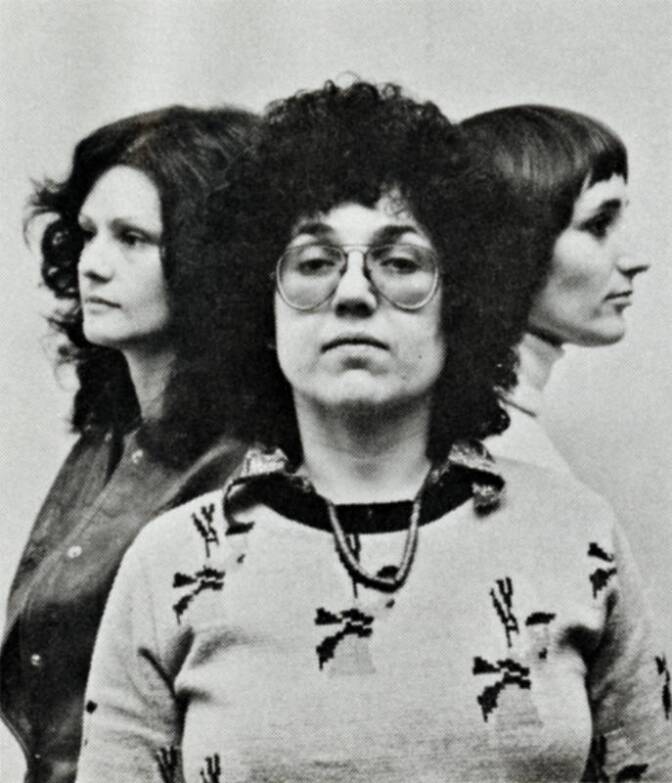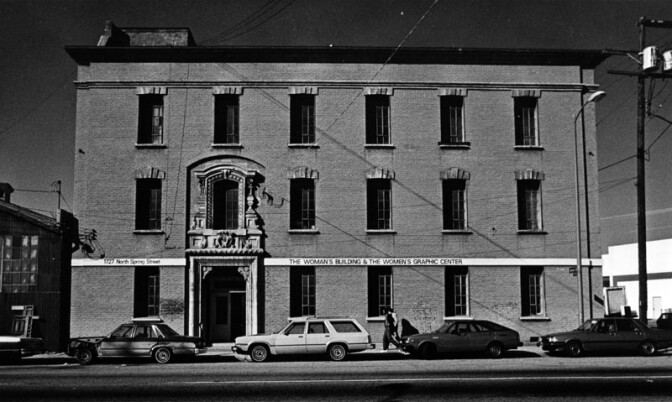1973 - 1991 The Woman’s Building
By Laura Dominguez
February 21, 2017
Founded as an act of protest, the Woman’s Building is a cornerstone in late twentieth-century lesbian and feminist culture. From 1973 to 1991, the Los Angeles-based organization and facility stood as a counterpoint to most major American museums, galleries, and arts programs, which routinely excluded female artists from their circles. Created by and for women, The Woman’s Building exemplified the impulse among feminists, including lesbians and bisexual women, to establish autonomous spaces outside of traditional, patriarchal institutions.

Three trailblazing women – artist Judy Chicago, art historian Arlene Raven, and graphic designer Sheila Levrant de Bretteville – came together in 1973 to create the first independent art school for women, the Feminist Studio Workshop (FSW). The founding of the FSW represented a crucial milestone for feminist activism within the art world, as activists increasingly targeted mainstream institutions for their broad dismissal of female artists....
Artist Cheri Gaulke, who was active at the Woman’s Building from 1975 to 1991, recounts: “We soon came to realize that it was an opportunity to be empowered, that we could learn skills that we’d never learned before and, more important, that we could just create our place in the world, which is really what The Woman’s Building represented. It was a public center for women’s culture.”

The Woman's Building, North Spring Street, Los Angeles, photographed in 1983 by Chris Gulker, courtesy of the Herald-Examiner Collection – Los Angeles Public Library
Throughout its 18-year run, The Woman’s Building cultivated an experimental space for women from around the world to explore ideas in feminist theory and sexuality through art. Artists whose work may have been marginalized in other venues found a platform for expressing political goals and viewpoints. The very notion of a public space for female artists underscored the existence of a distinctive “women’s culture” in the 1970s and ’80s, one that grappled with dynamics of gender, sexuality, race, and class to varying degrees.
Two of the FSW’s most ambitious projects were the Lesbian Art Project (LAP) and the Great American Lesbian Art Project (GALAS).
Arlene Raven, one of FSW’s co-founders, spearheaded LAP with writer and performer Terry Wolverton. Composed of workshops, performance pieces, and exhibitions, LAP sought to challenge common portrayals or misconceptions of lesbian culture and to elevate the contributions of lesbians to art history. The project lasted from 1977 to 1979.
One of LAP’s most significant works was “An Oral Herstory of Lesbianism,” written and directed by Wolverton. The 13-member performance took place at The Woman’s Building in 1979 and featured a series of vignettes exploring lesbian experiences and struggles.
 Promotional photos from "An Oral Herstory of Lesbianism" directed by Terry Wolverton. Courtesy of the Woman's Building Image Archive, Otis College of Art and Design Library.
Promotional photos from "An Oral Herstory of Lesbianism" directed by Terry Wolverton. Courtesy of the Woman's Building Image Archive, Otis College of Art and Design Library.Under GALAS, students and staff of the FSW examined the current state of lesbian art across the United States. The group held both formal and underground exhibitions throughout the country in 1980.
GALAS stood in contrast to other projects in that its curators directly confronted issues of race and exclusion within the queer and feminist art movements. Reflecting racial and economic dynamics in the 1970s and ’80s, women of color were largely left out of institutional activities and conversations in the art world. Through alliances with other artists and nonprofits, the project exceeded its original scope by bringing greater recognition to the experiences of lesbians of color. The Women’s Building itself grappled with ongoing questions about inclusion and attempted, with varying degrees of success, to address diversity issues through its programming and leadership.